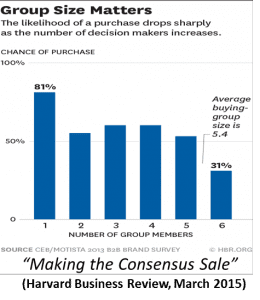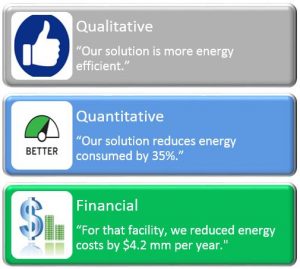 Do you remember your first adrenaline rush?
Do you remember your first adrenaline rush?
There is a good chance that it came from fear, anxiety or stress: states of mind that happen to all of us.
Some people enjoy the adrenaline and deliberately or impulsively make choices to get their adrenal glands working overtime.
The best B2B jobs for adrenaline junkies are in front of customers. Sales and presales conversations consistently generate fear and anxiety because they are routinely high stakes and because they are so unpredictable.
 Adrenaline may help, but sales and presales professionals need more than biological responses to perform effectively. Marketing and Product Management are generally responsible for providing content and tools that sales teams can use, whether or not they personally spend time in front of customers in a presales role. Sales teams need content, tools and preparation to improve their odds of performing well in the face of buyer uncertainties.
Adrenaline may help, but sales and presales professionals need more than biological responses to perform effectively. Marketing and Product Management are generally responsible for providing content and tools that sales teams can use, whether or not they personally spend time in front of customers in a presales role. Sales teams need content, tools and preparation to improve their odds of performing well in the face of buyer uncertainties.
Two Types of Buyer Uncertainty. Sales routinely faces two types of uncertainties from their B2B buyers.
 Buyer Stakeholder Uncertainty. Increasingly, B2B buyers make consensus decisions. A Harvard Business Review survey showed that the average business buying group consists of more than five people. This lowers the likelihood of a sale and it means that sales teams need to overcome risk-averse behavior by individual buyer stakeholders. The uncertainties are substantial:
Buyer Stakeholder Uncertainty. Increasingly, B2B buyers make consensus decisions. A Harvard Business Review survey showed that the average business buying group consists of more than five people. This lowers the likelihood of a sale and it means that sales teams need to overcome risk-averse behavior by individual buyer stakeholders. The uncertainties are substantial:
- Uncertainty about who has the final say and how they might deal with dissent
- Uncertainty about stakeholder roles and influence in a group decision
- Uncertainty about which messages will resonate with which individual stakeholder
- Uncertainty about individual stakeholder risk appetite and how high each one sets the bar in terms of a standard of proof.
Building consensus is challenging in the face of stakeholders with different organizational roles, interests and experiences.
- Buying Process Uncertainty. Every B2B sales team faces different buyer processes that it continuously tries to understand, control and redefine. Yet there are a few simple buying processes that invariably occur. Almost any buyer will look to identify and
 prioritize opportunities before taking the time to put a team together to evaluate them. Buyers rarely spend significant purchasing and procurement resources on a purchase before there is an initial decision to move forward based on a business stakeholder evaluation. A buyer’s process is often unclear or opaque to sales teams. As events occur or as new information becomes available to buying teams, the process often changes as do the team’s priorities and the comparisons that the buying team is making. The buying process is often unclear to buyer stakeholders as well. Identification & Prioritization are frequently random and may occur with or without direct interaction with vendors. Evaluation may be more or less organized. Evaluation teams change as organizational politics sometimes enter the fray. Contract and procurement processes can be a mystery not only to sales teams, but to buyer sponsors internally as well.
prioritize opportunities before taking the time to put a team together to evaluate them. Buyers rarely spend significant purchasing and procurement resources on a purchase before there is an initial decision to move forward based on a business stakeholder evaluation. A buyer’s process is often unclear or opaque to sales teams. As events occur or as new information becomes available to buying teams, the process often changes as do the team’s priorities and the comparisons that the buying team is making. The buying process is often unclear to buyer stakeholders as well. Identification & Prioritization are frequently random and may occur with or without direct interaction with vendors. Evaluation may be more or less organized. Evaluation teams change as organizational politics sometimes enter the fray. Contract and procurement processes can be a mystery not only to sales teams, but to buyer sponsors internally as well.
Inevitable Buyer Questions. In the midst of these uncertainties, sales teams can count on buyers needing answers to three questions: (1) what positive impacts can buyers of your  product expect on their business? (2) is your solution better for buyers than the alternative? (3) is your solution worth the cost?
product expect on their business? (2) is your solution better for buyers than the alternative? (3) is your solution worth the cost?
These questions come up throughout a buying process, often more than once as different stakeholders get involved, as comparisons are made to different alternatives and as the bar is set higher in terms of proof points as evaluation progresses.
Value Propositions Provide Answers. Value Propositions provide a tool to engage in an evolving conversation with customer stakeholders about what your solution can do for them. Sales teams perform best if they have a Value Proposition that is effective at all stages of the  sales cycle with or without the involvement of presales experts in the sales team with specialized knowledge and skills. As sales conversations progress, a Value Proposition needs to be adaptable to customer specifics, customer needs and customer stakeholder interests.
sales cycle with or without the involvement of presales experts in the sales team with specialized knowledge and skills. As sales conversations progress, a Value Proposition needs to be adaptable to customer specifics, customer needs and customer stakeholder interests.
Good Value Propositions provide clear answers to simple questions:
- Can you deliver meaningful, reliable business results to customers like us?
- What are the 2 or 3 impactful differences between your solution and the alternatives?
Yet too many Value Propositions start life as a nice analytical spreadsheet or an ROI calculator and never progress beyond that. These financial or dollarized Value Propositions are often structured as stand-alone content, designed for a closing conversation and can only be presented by the spreadsheet’s author. These calculators usually miss the opportunity to scale value conversations through other members of the sales team and always miss the opportunity for sales reps to have value conversations early in the sales cycle.
3 Layers of a Value Proposition. Winning Value Propositions recognize that different elements of the Value Proposition are useful:
- at different stages of the sales cycle
- for different conversations
- by different members of the sales teams
- with different customer shareholders
- to address different questions.
Not all elements of a financial case to buy your product are necessarily useful in all customer conversations. B2B sales processes require a series of steps that include qualifying an account,  identifying stakeholders, understanding and collaboratively supporting a customer’s buying process, obtaining a customer commitment to evaluate and persuading the customer that your solution is worth the money and is better than the alternatives. At most stages of the process, the objective is to move the ball down the field, not to engage in mathematical proof.
identifying stakeholders, understanding and collaboratively supporting a customer’s buying process, obtaining a customer commitment to evaluate and persuading the customer that your solution is worth the money and is better than the alternatives. At most stages of the process, the objective is to move the ball down the field, not to engage in mathematical proof.
Value Propositions should be designed to play a flexible and versatile role in the sales process. Value Propositions work best if their content is layered. As illustrated to the left, what you do for your customers can be expressed in three ways:
- Qualitative
- Quantitative
- Financial
Layers, Flexibility and Options. But layering a Value Proposition is not enough in the face of buyer uncertainties. Too often, spreadsheet authors are only able to present their value as a straight line, one-way presentation, failing to elicit customer reactions or to stimulate buyer engagement. PowerPoint slides that highlight layered value messages may provide good qualitative and quantitative content, but still are usually structured for point-to-point, monologue presentations that go deeper into detail than is necessary for almost any specific buyer discussion.
The problem becomes the general one of “TMI”, a problem that the best reps navigate to avoid when working with their presales colleagues. Presales professionals who talk too much and who don’t engage with or listen to customers rarely develop distinct, trusted advisory relationships with stakeholders.
This is where options can and should be built into a Value Proposition for it to be an effective sales tool. Options provide tactical flexibility in how to discuss value in specific customer situations. Options provide the ability to pivot a conversation toward your solution’s value drivers that resonate best with a specific or targeted stakeholder. Options allow for transparent, well-informed conversations with the customer without showing so much detail that sales or presales find themselves drawn into needless tangents or hijacked meetings.
Analytical Value Proposition authors sometimes get hung up on all the possibilities, throwing in the towel on designing flexibility and optionality in their Value Propositions. If they build in flexible options, they often build them all into one big decision-tree, overwhelming the sales or presales user with too many discovery questions prior to having any conversation.
The best approach for Product Managers and Marketing is to consider the sales process: to ask experienced sales reps about successful approaches they have deployed early and late in the sales process. The objective is then to connect elements of the value content with different types of conversations, keeping in mind the objectives of those specific conversations. Organizing value content to fit typical conversations and providing natural options for those conversations, helps to simplify and make content usable for sales teams.
Provide Valuable Sales Team Options. Good sales and presales professionals understand that they need to make snap decisions in meetings all the time. It is a big contributor to their adrenaline rush. Giving them simple ways to make smart decisions provides them with better supporting content and facilitates better control of meetings, improving the effectiveness of their sales process.
CRM data from organizations adopting value selling show that opportunities where a Value Proposition is used have 5-15% higher win rates and 5-25% higher price outcomes. Sales interviews suggest that well developed Value Propositions improve sales effectiveness, even when Value Propositions aren’t used, because sales teams have confidence in their ability to provide insights into how their solution delivers tangible business benefits, whether or not they need to. This is reason enough to provide flexible, layered Value Propositions to sales teams.
Design Useful Tools. The best B2B enterprises deploy Value Propositions to improve B2B sales team performance, addressing sales challenges throughout the B2B sales cycle. For  account executives and sales reps, they are useful early in the sales cycle as Flexible Case Studies in call preparation, in building sales confidence, in qualifying opportunities and in engaging customer executives. For technical sales and presales professionals, joining the team in the middle of the sales process, Value Propositions provide Customer Value Analyses as an important way to address presales challenges. As customers decide to purchase, the Value Proposition becomes a Shared Business Case, collaboratively agreed between sales executives and customer sponsors, that serve as a buyer’s internal financial justification to purchase.
account executives and sales reps, they are useful early in the sales cycle as Flexible Case Studies in call preparation, in building sales confidence, in qualifying opportunities and in engaging customer executives. For technical sales and presales professionals, joining the team in the middle of the sales process, Value Propositions provide Customer Value Analyses as an important way to address presales challenges. As customers decide to purchase, the Value Proposition becomes a Shared Business Case, collaboratively agreed between sales executives and customer sponsors, that serve as a buyer’s internal financial justification to purchase.
It isn’t hard to start value selling. Value Propositions provide core sales content that helps sales teams communicate what your solution does for your customers. Value Propositions are a shared basis for collaboration that help sales teams win.

